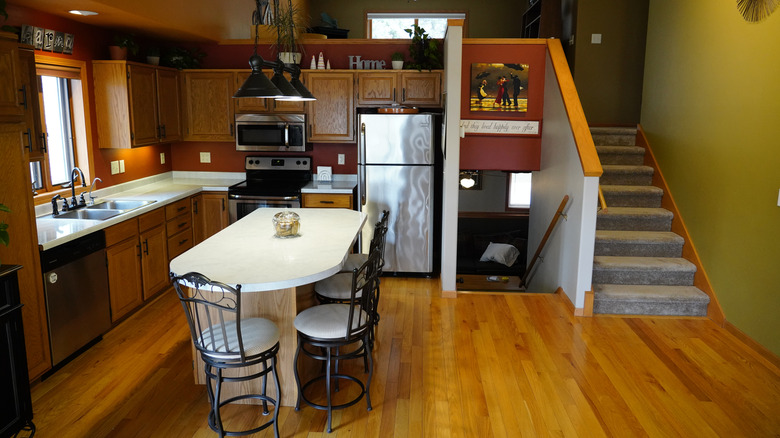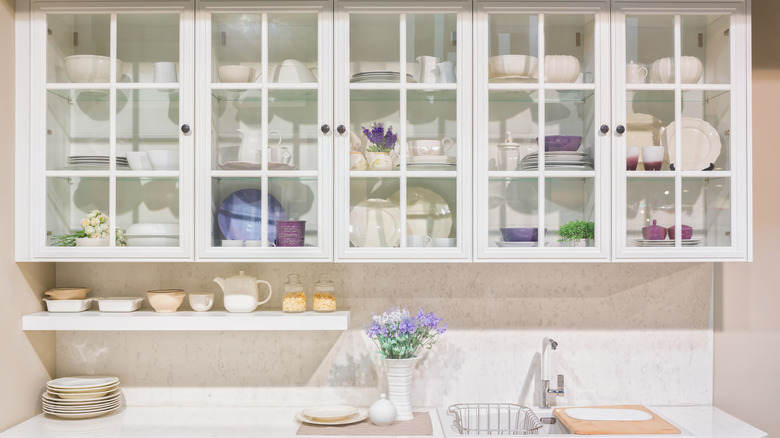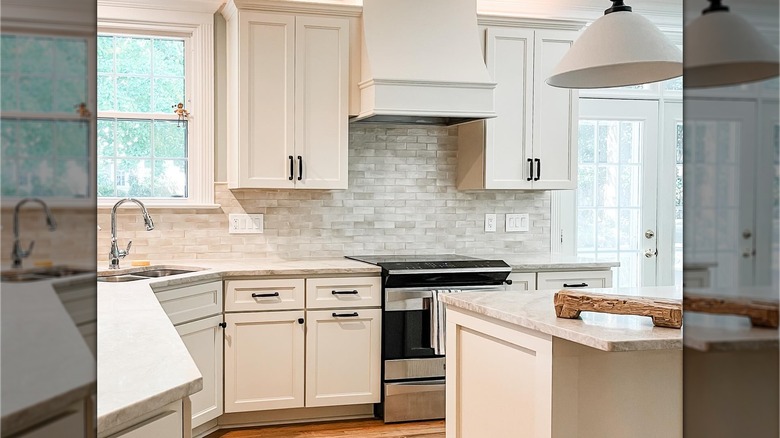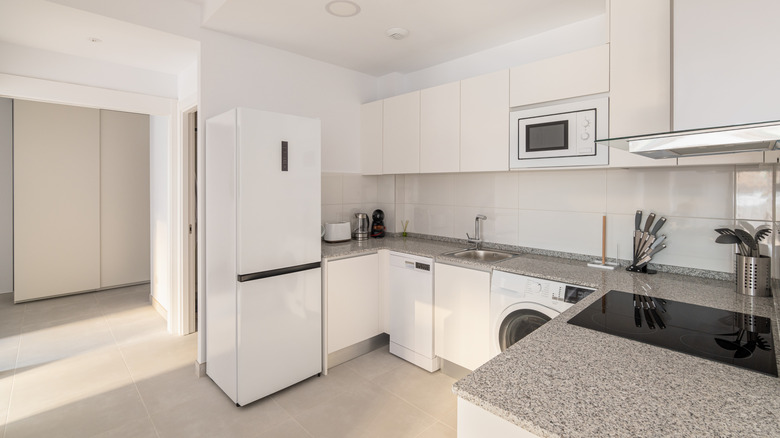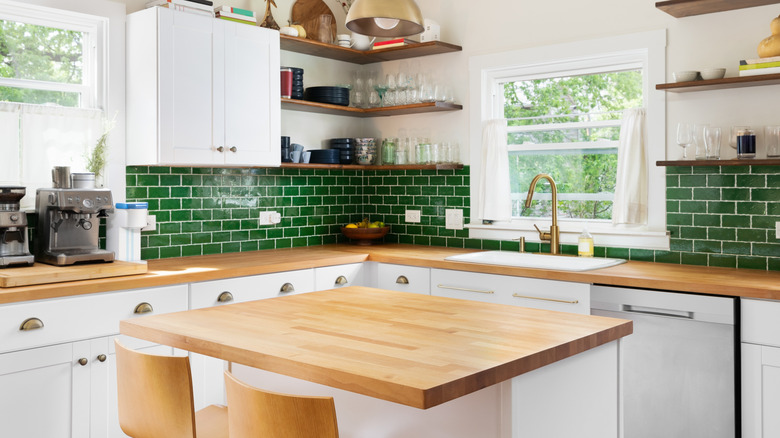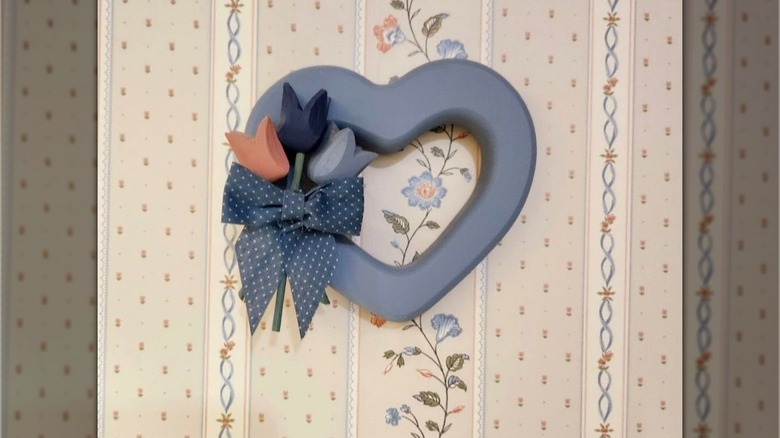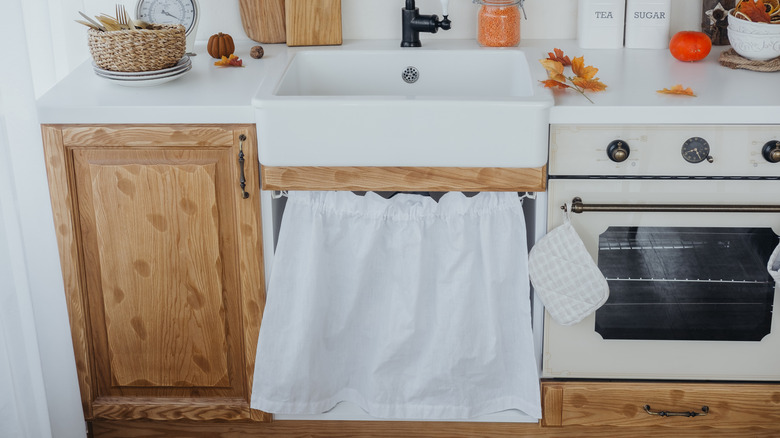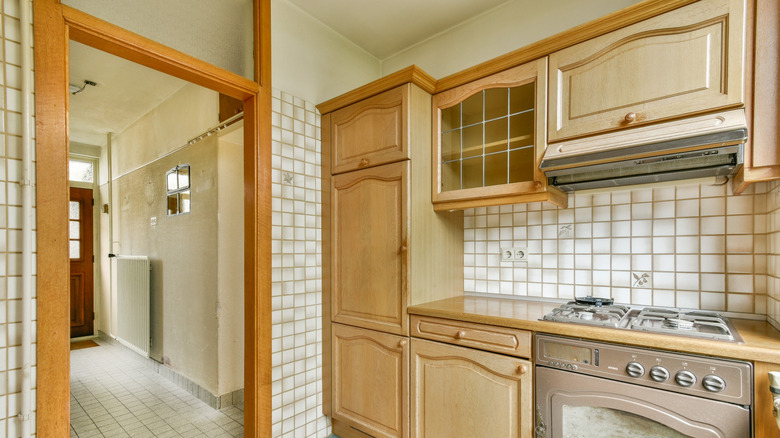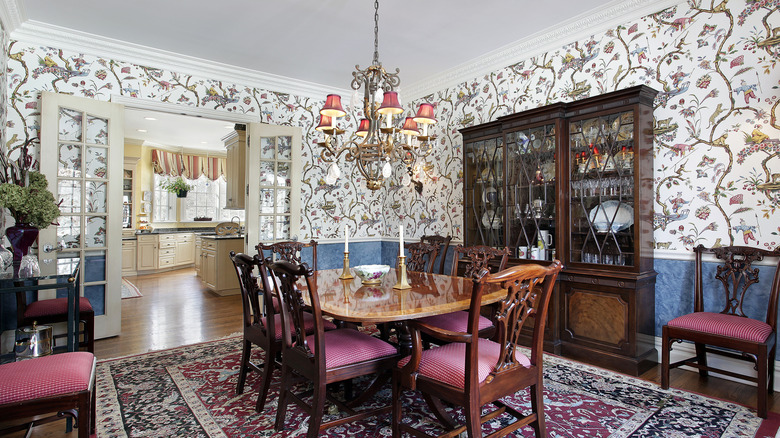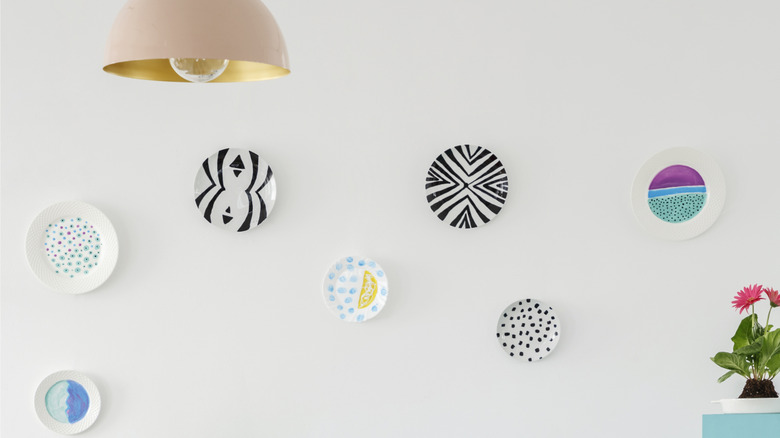10 '90s Kitchen Design Trends We Think Need A Comeback
Kitchen trends come and go, but some come back again and again. Each re-appearance of a trend is a little different than before because people aren't just re-creating old styles; they're adding contemporary twists that make these older trends look almost new. For the past couple of years, trends from the 1990s have made their way back into homes — especially the kitchen — and this should be cause for celebration.
The 1990s were creative and colorful while still prioritizing comfort and practicality. Neutral base colors allowed bold highlights to really pop, elegant glass made it easy to find whatever you needed, and wood cabinets and countertops added warmth. Patterned tiles displayed creativity, and cozy textiles let homeowners give the kitchen a highly personalized and relaxed touch. If you want your kitchen to be more than just a space where you store food and make dinner, it's time to reconsider these 10 '90s kitchen design trends.
Glass-front cabinet doors
One of the more practical 1990s trends that's coming back is the glass-front cabinet door. It's a perfect way to see everything you have — this is great if you tend to have an "out of sight, out of mind" mindset and routinely forget what you have stored away — while keeping everything free of dust. The only real drawbacks to glass-front cabinets are that you have to be sure everything is stored neatly (you really don't want to show your dinner guests several shelves' worth of clutter), and you have to be careful not to damage the glass.
Glass-front cabinets can help make a smaller kitchen seem a little more open because you don't have solid cabinet doors forming what's essentially an extra wall. You see the depth of the shelves, which contributes to an illusion of more space. You can add some decorative plates or knick knacks, too, and if you add some spotlights, those will obviously make the kitchen look brighter. The cabinets are wonderful to have in more spacious kitchens, as the glass doors add variety to what would otherwise be a bland mass of solid cabinet doors. Adding glass doors with decorative muntins — those strips of wood that divide up the panes — can make the kitchen look classy.
The Nancy Meyers look
Nancy Meyers is a director whose credits include films like "Something's Gotta Give" and the remake of "Father of the Bride." Her films feature homes with cozy decor that's also trim and neat, with lots of neutrals (think beige, ivory, and magnolia), open shelving, hanging pot racks, and obvious quality in the fixtures and pieces that the set designer chose. The homes look stylish but also lived-in, such as having a couch with wide, plain seat cushions that could have come right from a showroom, and then covering it with comfy throw pillows and blankets that really look like someone was using them earlier in the day.
This style has seen a massive rise in popularity once again, with Nancy Meyers-devotees trying to mimic that aesthetic as closely as possible. This is a fun '90s trend to aim for if you love vintage pieces; those secondhand finds from the 1990s are not only accurate in terms of decade, but they also have a slightly shabby used look that works perfectly with the aesthetic. If you're remodeling, add open shelves, that pot rack, and beige or magnolia paint; if you're merely redecorating, add vintage 1990s decorations in blue or a neutral color, and try to add wood furniture like chairs.
Patterns as highlights
One thing that really stands out about kitchens before 2000 is that so many had patterns. Patterned tiles, backsplashes, and wall decorations ruled the day, from black and white checkerboard flooring to gingham curtains. Flora and fauna were common patterns on dishtowels and dishware, cushions, clocks, and more. Somehow, all of this was dumped for the futuristic and rather plain swathes of steel and gray. Even if a kitchen used warmer colors, you wouldn't see patterned floor tile — you'd see laminate or luxury vinyl tile that mimicked wood flooring.
It's time for those patterns to come back. Look into floor tile patterns if the cabinets and counters are going to be solid colors, or bring back patterned backsplashes that are nice to look at, even when you're not cooking. Forget using one color of subway tile; while there's nothing inherently wrong with having a subway tile wall that's all one color, you can make the wall look much more interesting with a few accent tiles in different colors. Seek out vintage wall and counter tiles that have graphics on them like flowers or fruit, and include those in your backsplashes. Not doing any big renovations? Switch out your plain kitchen blinds for a soft, patterned curtain, and add a kitchen mat and textiles that match.
White appliances
After the avocado green and harvest gold of the 1970s, kitchen appliances in the 1980s and 1990s were usually white or a close shade. However, those hues fell out of favor as stainless steel took over toward the end of the decade, with some people opting for black appliances if they didn't like stainless steel. White appliances were considered boring and outdated, not to mention, cheap. That was great if you didn't have a big budget for appliances, but also not so great if you were hoping to make your kitchen look stylish.
That's been changing. White appliances have been back in fashion for a few years now, with bright white being among the more popular shades. White also allows you to see dirt better and know what spots need cleaning (Hiding dirt isn't something you really want to do in a kitchen). People who have chosen white appliances haven't really regretted their choices, with some noting that the dreaded fingerprints that always showed up on stainless steel are no longer a problem. White is also basic enough that it can go with many different color schemes and styles.
The wood butcher block countertop
Kitchens in the 1990s often had a butcher block in the center that doubled as a kitchen island, and it wasn't unusual to see all the countertops made of the same material. A butcher block refers to two things. One is a thick, heavy wooden block that is traditionally used by butchers as a cutting surface. The other is the surface used on many kitchen islands and counters that is made in a similar style, with strips of wood glued together to form a thick, sturdy surface. The butcher blocks used as kitchen islands weren't always fixed to one spot, and it was common for them to be mobile, similar to the wheeled carts that you can buy online.
These butcher-block countertops are back in style, and they have some pros that you'll want to consider if you're remodeling. This material is often a lot cheaper than stone countertops, and it's not as cold, visually and physically, as something like marble. They're easier to repair than stone because you can sand wood to remove small scratches and stains. The cons to using them are that they do require maintenance, like oiling (similar to how you have to seal granite countertops every so often). They may be easier to repair than stone, but they're more prone to damage. Installation may also require more work than a stone countertop would need.
Dusty rose, sage green, and country blue
Kitchens in the 1990s often had comforting color schemes with three particular colors showing up again and again: sage green, dusty rose, and country blue. Think faded roses on a soothing blue background, along with a medium green color, all showing up in wallpaper, carpets, decorations, and textiles. Cookie jars and juice glasses had geese decor on them, too, with the geese often in country-blue bonnets. Like mauve in the 1980s and avocado green and harvest gold in the 1970s, this trio faded away as the 21st century picked up steam.
Dusty rose actually regained attention in the late 2010s as people tried to add more color to the gray and brown color schemes that took over so many new homes and apartments. That being said, it would be nice to have it come back once again, this time with its friends sage green and country blue. Many people have fond memories of the trio from the 1990s, and honestly, we could do with more comforting decor right now instead of the cold, gray shades that still seem to dominate many homes.
The skirted base cabinet (if you remember to clean it)
Most kitchen sinks sit above a cabinet with two doors, but a variation on this is the cabinet skirt or sink skirt. This is a curtain that sits on a tension rod in place of the doors, and it's a wonderful choice if you want to add more color or even change the theme of your kitchen decor each season or for different holidays. Skirted cabinets have been around since the 19th century, but they saw a surge in popularity during the 1990s. Now, their time has come once again.
Cabinet skirts are quiet; no slamming doors to worry about. Grabbing something from the cabinet is quick, and you don't have to care for hinges. As mentioned, you can change the curtains to suit your mood or choice of decor. Even a solid color can break up the monotony of a long row of base cabinets. There's just one issue with cabinet skirts, though, and that's keeping them clean. Be prepared to remove the skirt and wash it regularly, and don't let it drag on the floor. Cloth can trap dust plus food drips and spills, leading to bacterial or fungal growth — remember, you can't just wipe those up off curtains like you can from a hard surface. That said, it's much easier to toss and replace a skirt/curtain than it is to repair or replace a damaged cabinet door.
Warm wood colors for cabinets
If glass-front cabinets aren't your thing, another 1990s option is an all-wood cabinet in a warm color, such as honey oak. Cabinets have been one of the more variable features of kitchens, with everything from white to gray to dark wood colors showing up in kitchens for the past couple of decades. The light, warm tones that were often seen in the 1990s haven't gotten as much attention — until now.
If you currently have older upper cabinets from the 1990s that were never upgraded, your job is relatively easy: clean and stain the cabinets to make them look like new, and then change the hardware (handles, hinges, and so on) to something more up to date. If you're replacing upper cabinets, you'll want to pay attention to the style and shape of the new cabinets, especially the doors and drawer fronts. The warmer wood colors look great both on 1990s-style doors and on more modern options (And yes, you can find glass-front doors in warm wood colors, too, if you want the best of both worlds).
Lower cabinets are another matter. You can stick with warm wood colors if you really like them, but you may also want to consider painting the lower cabinets a lighter color that blends in more with the rest of the kitchen, such as white. An all-wood kitchen can sometimes look like too much wood, depending on the number of cabinets you have.
Floral wallpaper
This one is seen more often in the dining room than by the stove, but it's been so popular that it's worth mentioning. Floral wallpaper was huge in the 1990s, although the current trend uses a somewhat different approach. Instead of having lots of floral wallpaper and other textiles that use a floral pattern all over your kitchen, the trend now is to create an accent wall. You remember how apartments for rent around the mid-2000s started offering one wall painted a dramatic color? Use the floral wallpaper to create that accent wall instead of paint.
One aspect of this trend that gets mixed reviews is the wallpaper border. That's when you have a relatively narrow strip (a few inches) of wallpaper running horizontally along a wall or around a room. Some designers say absolutely not, but others like the idea. If you're considering adding a border, you might want to choose a more subtle floral pattern that works as a transition between whatever is on either side. A bold pattern could stand out too much and end up being more visual noise than pretty decoration.
Using plates as wall decoration
Having a display of plates on the wall as decoration is one of the best examples of how a trend can resurface multiple times as new generations try it out. It's coming back now in the mid-2020s, it came back in the 1990s, it was briefly back in the 1970s, it was rather big in the 1950s — and apparently, even that was a repeat occurrence of the trend. It's not that surprising to find that hanging plates on the wall (or placing them on their edges on a shelf) has been so popular over the decades because it's a simple trend to get into; all you need are plates you think are pretty and the appropriate hardware for hanging them. You can have mismatched plates or a matching set, you can change them according to the season, and you can use them to temporarily fill in blank spaces. It's also a great way to display cute-but-mismatched vintage plates or elegant heirlooms without taking up counter space.
You do need to keep a few issues in mind if you try this. One is that where you hang the plates can drastically change not just the look but also the feel of the room. Hanging them up too high can make them seem oppressive. You also want to avoid making the room feel more cluttered. Take your time when choosing the plates and choosing where to hang them.
